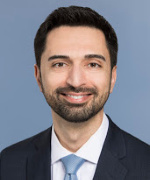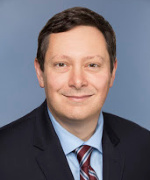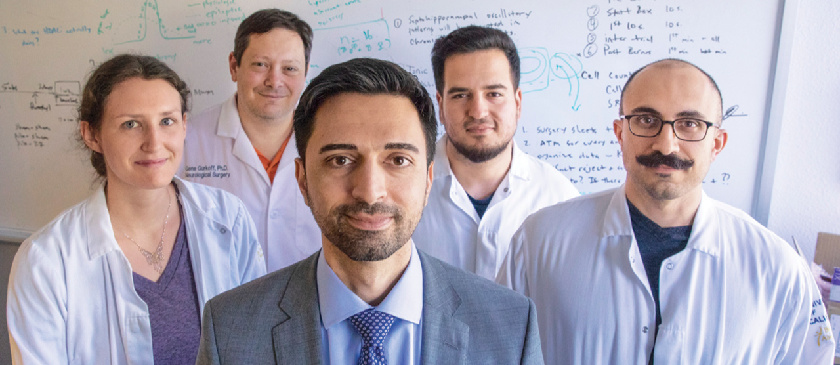Neuromodulation Research Program
Our Neuromodulation Research Program is committed to translating cutting edge research performed in our laboratory at the Center for Neuroscience in Davis into clinical studies at the UC Davis Medical Center in Sacramento. The goal of our program is to develop new therapeutic strategies to improve quality of life for patients with disabling neurological conditions. Our specific focus is on the use of electrical neuromodulation, targeted delivery of electrical stimulation to specific brain regions, to alter brain activity and improve clinical outcomes. Our hypotheses are that many neurological disorders, such as seizures and cognitive decline, are the result of abnormal electrical activity within the brain and that targeted therapy using neuromodulation can improve quality of life by reducing seizures and improving cognitive performance.
An additional important goal of our research program is to train the next generation of scientists: undergraduates, graduate students, medical students, and clinical residents. We provide our trainees a unique experience, learning how to develop and test hypotheses in the context of understanding and treating neurologic disorders.
Faculty Directors
 |
Kia Shahlaie, M.D., Ph.D. |
 |
Gene Gurkoff, Ph.D. Associate Professor of Neurological Surgery |
Trainees
Current Trainees
Ali Izadi, Ph.D.
Postdoctoral Fellow
Jacqueline Overton, Ph.D.
Postdoctoral Fellow
Sy Clark, B.S.
Medical Student Research Fellow
Past Trainees
Katelynn Ondek, B.S., Ph.D.
Neuroscience Graduate Student; Veterinary Student
Arjang Ahmadpour, M.D., M.S.
Medical Student T32 Scholar; Neurosurgery Resident
Lucy Ogbu-Nwobodo, M.D.
Medical Student T32 Scholar; Psychiatry Resident
Katherine Scangos, M.D., Ph.D.
Resident Physician K32 Scholar; Assistant Professor of Psychiatry
Darrin Lee, M.D., Ph.D.
Neuroscience Graduate Student; Assistant Professor of Neurosurgery
Pre-Clinical / Translational Research
Theta Frequency Stimulation of the Medial Septal Nucleus in Epilepsy
Investigator: Gene Gurkoff, Ph.D.
Altered Neural Activity and Seizures: Can Deep Brain Stimulation improve outcome following toxic exposure to organophosphates.
Investigators: Gene Gurkoff, Ph.D.
Clinical Research
Deep Brain Stimulation of the Medial Septal Nucleus in Epilepsy
Investigators: Kia Shahlaie, M.D., Ph.D.; Gene Gurkoff, Ph.D.
Dual Region, Dual Frequency Deep Brain Stimulation of the Subthalamic Nucleus in Parkinson’s Disease
Investigators: Kia Shahlaie, M.D., Ph.D.; Gene Gurkoff, Ph.D.
Role of the Ventral Subthalamic Nucleus in Cognitive Processing
Investigators: Ignacio Saez, PhD; Kia Shahlaie, M.D., Ph.D.
Microlesion Effect on Basal Ganglia Electrophysiology
Investigators: Kia Shahlaie, MD, PhD; Ignacio Saez, Ph.D.
Electrocorticography of human prefrontal cortex during value-based decision-making
Investigator: Ignacio Saez, Ph.D.
Bronte Endowment
The Bronte Research Program was established by a generous endowment to support research in epilepsy and other neurological disorders that result in seizures and cognitive dysfunction. The donation established the Bronte Chair, Dr. Kia Shahlaie, and has supported numerous innovative preclinical and clinical studies in patients with epilepsy and other neurological disorders. This endowment has supported research that has led to important discoveries about the basic mechanisms related to the development, progression and treatment of epilepsy and cognitive disorders. For more information about the Bronte Program, please visit: www.bronteepilepsyresearch.org/family.html.
Chevo Foundation Grant
The Chevo Foundation was established by Mr. Chevo Ramirez, a philanthropist and former Regional Vice President of the Wells Fargo Foundation. After being diagnosed with Parkinson’s disease, Mr. Ramirez established the Chevo Fund to support research into prevention, diagnosis, and treatment of Parkinson’s disease. The Foundation’s gift to has allowed our team to perform innovative preclinical research and pilot clinical trials exploring novel treatment strategies for the cognitive effects of Parkinson’s disease. For more information about the Chevo Foundation, please visit: https://www.sacregcf.org/donors/partnering-with-us/fundholder-stories-fund-list/the-chevo-fund/.
Anonymous Donations
Our research program has also received very generous support from patients and family members that have chosen to remain anonymous. We are extremely grateful for these gifts, which have made a significant positive impact on our ability to pursue a variety of preclinical and clinical research projects.
- Kishida KT, Sandberg S., Lohrenz T., Comair YG, Saez I, Phillips PEM and Montague PR. Sub-second dopamine detection in human striatum. PLoS ONE, Aug 2011.
- Gurkoff GG, Shahlaie K, and Lyeth BG. In vitro mechanical strain trauma alters neuronal calcium responses: Implications for posttraumatic epilepsy. Epliepsia 53(suppl.1); 53-60, 2012.
- Lee DJ, Gurkoff GG, Izadi A, Berman RF, Ekstrom AD, Muizelaar JP, Lyeth BG and Shahlaie K. Medial septal nucleus theta frequency deep brain stimulation improves spatial working memory after traumatic brain injury. J Neurotrauma 30(2); 131-139, 2013.
- Watrous AJ*, Lee DJ*, Izadi A, Gurkoff GG, Shahlaie K, and Ekstrom AD. A comparative study of human and rat hippocampal low frequency oscillations during spatial navigation. Hippocampus 23(8); 656-661, 2013.
- Lee DJ, Gurkoff GG, Goodarzi A, Muizelaar JP, Boggan JE, and Shahlaie K. Intracerebroventricular opiate infusion for refractory head and facial pain. World Journal of Clinical Cases 2(8); 351-356, 2014.
- Saez I, Set E and Hsu M. From genes to behavior: placing cognitive models in the context of biological pathways. Frontiers in Neuroscience, 2014 Nov 4;8:336.
- Wang XH, Zhang L, Sperry L, Olichney J, Farias ST, Shahlaie K, Chang NM, Liu Y, Wang SP, Wang C. Target selection recommendations based on impact of deep brain stimulation surgeries on nonmotor symptoms of Parkinson's disease. Chinese Medical Journal (English) 128(24); 2271-2280, 2015. Doi: 10.4103/0366-6999.171464.
- Lee DJ, Gurkoff GG, Izadi A, Echeverri A, Melnik M, Berman RF, Ekstrom AD, Muizelaar JP, Lyeth BG, and Shahlaie K. Hippocampal theta frequency modulation for cognitive and electrophysiological improvement following traumatic brain injury. J Neurotrauma 32(22); 1822-1832, 2015.
- Saez I, Zhu L, Set E, Kayser A and Hsu M. Dopamine Modulates Egalitarian Behavior In Humans. Current Biology, Mar 2015.
- Lee DJ, Zwienenberg-Lee M, Seyal M, Shahlaie K. Intraoperative computed tomography for intracranial electrode implantation surgery in medically refractory epilepsy. J Neurosurg. 2015 Mar;122(3):526-31. doi: 10.3171/2014.9.JNS13919.
- Pevzner A, Izadi A, Lee DJ, Shahlaie K,and Gurkoff GG. Making waves in the brain: What are oscillations, and why modulating them makes sense for brain injury (Review). Front Syst Neurosci. 2016.
- Kishida KT, Saez I, Lohrenz T, Witcher MR, Laxton AW, Tatter SB, White JP, Ellis TL, Phillips PEM, Montague PR. Sub-second dopamine fluctuations in human striatum encode superposed error signals about actual and counterfactual reward. Proceedings of the National Academy of Sciences, Jan 2016.
- Hetu S, Luo Y, Saez I, D’Ardenne K, Lohrenz T and Montague PR. Asymmetry in functional connectivity of the human habenula revealed by high-resolution cardiac-gated resting state imaging. Human Brain Mapping, Apr 2016.
- Vass LK, Copara MS, Seyal M, Shahlaie K, Farias ST, Shen PY, Ekstrom AD. Oscillations go the distance: low-frequency human hippocampal oscillations code spatial distance in the absence of sensory cues during teleportation. Neuron 2016 Mar 16;89(6):1180-1186. doi: 10.1016/j.neuron.2016.01.045.
- Lee DJ, Izadi A, Melnik M, Seidl S, Echeverri A, Shahlaie K, and Gurkoff GG. Stimulation of the medial septum improves performance in spatial learning following pilocarpine-induced status epilepticus. Epilepsy Res. 130; 53-63, 2017.
- Scangos KW, Shahlaie K. Acute frequency-dependent hypomania induced by ventral subthalamic nucleus deep brain stimulation in Parkinson's disease: A case report. Biol Psychiatry 2017 Sep 1;82(5):e39-e41. doi: 10.1016/j.biopsych.2016.12.003.
- Yuan M, Sperry L, Malhado-Chang N, Duffy A, Wheelock V, Farias S, O'Connor K, Olichney J, Shahlaie K, Zhang L. Atypical antipsychotic therapy in Parkinson's disease psychosis: A retrospective study. Brain Behav. 2017 Apr 14;7(6):e00639. doi: 10.1002/brb3.639. eCollection 2017 Jun.
- Moran R*, Kishida KT*, Lohrenz T*, Saez I, Laxton A, Witcher M, Tatter S, Ellis T, Phillips PEM, Dayan P, Montague PR. The protective action encoding of serotonin transients in the human brain. Neuropsychopharmacology, Jan 2018.
- Scangos KW, Carter CS, Zhang L, Gurkoff GG, and Shahlaie K. A pilot study of theta frequency deep brain stimulation for cognitive dysfunction in Parkinson’s disease. Brain Stimulation. 11(2); 456-458, 2018.
- Kolarik BS, Baer T, Shahlaie K, Yonelinas AP, Ekstrom AD. Close but no cigar: Spatial precision deficits following medial temporal lobe lesions provide novel insight into theoretical models of navigation and memory. Hippocampus 2018 Jan;28(1):31-41. doi: 10.1002/hipo.22801.
- Stolk A, Griffin SM, van der Meij R, Dewar C, Saez I, Lin JJ, Piantoni G, Schoffelen JM, Knight RT, Oostenveld R. Integrated analysis of anatomical and electrophysiological human intracranial data. Nature Protocols, Jul 2018.
- Gao X, Yu H, Saez I, Blue PR, Zhu L, Hsu M, Zhou X. Distinguishing neural correlates of context-dependent advantageous and disadvantageous inequity aversion. PNAS, Jul 2018.
- Saez I, Lin JJ, Stolk A, Chang EF, Parvizi J, Schalk G, Knight RT and Hsu M. Encoding of multiple reward-related factors in transient and sustained high-frequency activity in human OFC
Current Biology Sep 2018. - Izadi A*, Ondek K*, Schedlbauer A, Keselman I, Shahlaie K, and Gurkoff G. Clinically indicated electrical stimulation strategies to treat patients with medically refractory epilepsy. Epilepsy Open 3(Suppl 2);198-209, 2018.
- Izadi A, Pevzner A, Lee DJ, Ekstrom A, Shahlaie K, and Gurkoff GG. Medial septal nucleus stimulation increases seizure threshold and improves cognitive function in a rodent model of temporal lobe epilepsy. Brain Stimulation. 12(3); 735-742, 2019.
- Moxon K, Shahlaie K, Girgis F, Saez I, and Gurkoff GG. From adagio to allegretto: The changing tempo of theta frequencies in epilepsy and its relation to interneuron function. Neurobiology of Disease. 129; 161-181, 2019.
- Girgis F, Zarabi H, Said M, Zhang L, Shahlaie K, Saez I. Comparison of intraoperative computed tomography scan with postoperative magnetic resonance imaging for determining deep brain stimulation electrode coordinates. World Neurosurg. 2020 Jun;138:e330-e335. doi: 10.1016/j.wneu.2020.02.108. Epub 2020 Feb 26.
- Girgis F, Ovruchesky E, Kennedy J, Seyal M,Shahlaie K, Saez I. Superior accuracy and precision of SEEG electrode insertion with frame-based vs. frameless stereotaxy methods. Acta Neurochir (Wien). 2020 May 26. doi: 10.1007/s00701-020-04427-1. Online ahead of print.
- Park K, Kanth K, Bajwa S, Girgis F, Shahlaie K, Seyal M. Seizure-related apneas have an inconsistent linkage to amygdala seizure spread. Epilepsia 2020 Jun;61(6):1253-1260. doi: 10.1111/epi.16518. Epub 2020 May 11.
The following is a summary of projects associated with our Neuromodulation Research Program:
2020-2021: “Dual frequency, dual region deep brain stimulation of the subthalamic nucleus in Parkinson’s disease.” PI: Shahlaie, UC Davis CTSC
2020 – 2025: “Precision and binding as two dimensions of medial temporal lobe amnesia.” PI: Ekstrom/Yonelinas, Co-I: Shahlaie, NIH
2019 – 2023: “Dynamic episodic – semantic memory interactions for flexible goal-driven agents.” PI: Ranganath/O’Reilly, Co-I: Saez and Shahlaie, Office of Naval Research
2018 – 2023: “Representation of spatiotemporal information in human episodic memory and navigation.” PI: Ekstrom, Co-I: Shahlaie and Gurkoff, NIH
2019 - 2021: “Machine-learning decoding of human memories during consolidation and recall using distributed invasive recordings.” PI: Saez, UC Davis Learning and Memory seed program.
2017 - 2021: "Centers without walls for collaborative research in the epilepsies: developing transformative therapies for modifying or preventing epilepsy (U54): The Epilepsy Bioinformatics Study for Antiepileptogenic Therapy." PI: Vespa, co-Is Shahlaie and Gurkoff, NIH
2014 - 2024: “Low frequency stimulation of ventral STN to improve cognition.” PI: Shahlaie, Co-I: Gurkoff, Chevo Foundation, Sacramento, CA
2016 - 2020: “Electrocorticography of human prefrontal cortex during value-based decision-making. ” PI: Saez, National Institutes of Mental Health.
2014 - 2020: “Restoring Functional Connectivity Following TBI” PI: Gurkoff, NIH NINDS
2017 - 2018: “Network level effects of ventral STN theta frequency deep brain stimulation on cognition in Parkinson’s disease.” PI: Shahlaie, UC Davis Interdepartmental Seed Grant
2014 - 2017: “Ventral subthalamic nucleus stimulation for cognition.” PI: Shahlaie, Co-I: Gurkoff: UC Davis/NIH K30 Training Grant
2016 - 2017: “Vagal nerve stimulation to improve cognition in animal models.” PI: Shahlaie, Co-I: Gurkoff, UC Davis/NIH T32 Training Grant
2011 - 2016: “MSC engineered to produce BDNF for the treatment of Huntington's disease.” PI: Wheelock, co-I: Shahlaie, CIRM Grant
2015 - 2016: “Vagal nerve modulation for seizure control and cognitive recovery.” PI: Shahlaie, Co-I: Gurkoff, UC Davis/NIH T32
2015 - 2016: “An integrated system to monitor, image and regulate neural activity.” PI: Krubitzer, Co-I Shahlaie, Cal-BRAIN Initiative.
2011 - 2012: “Deep brain simulation to improve memory after TBI.” PI: Shahlaie, UC Davis National Board of Advisors
2010 - 2011: “Stimulating hippocampal theta in rats following traumatic brain injury to improve functional outcome.” PI: Shahlaie, Co-I: Gurkoff, UCD CMGI Pilot Project Funds

